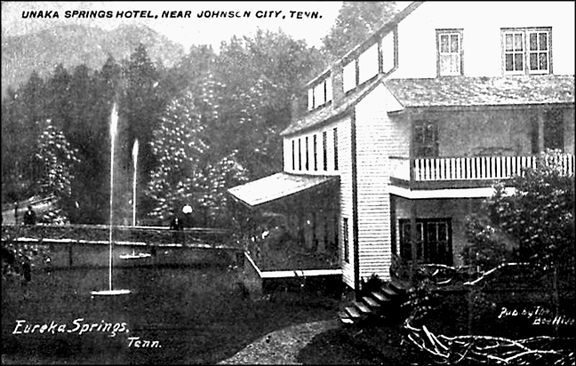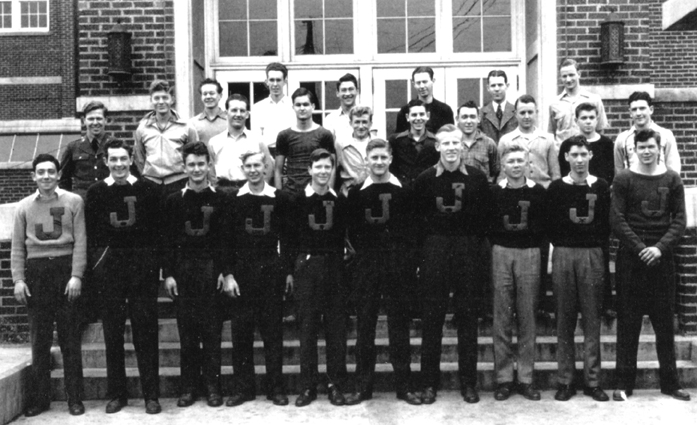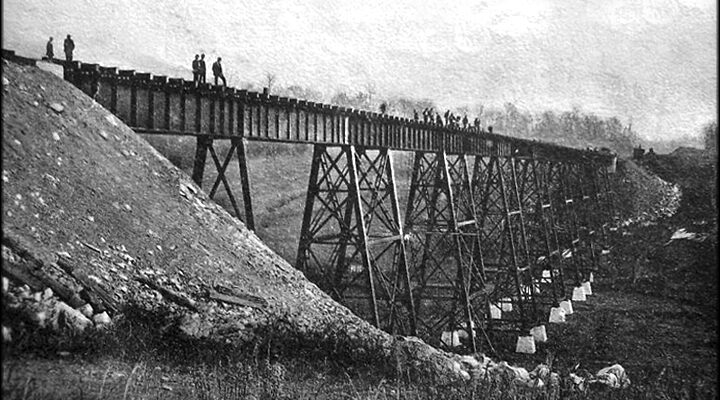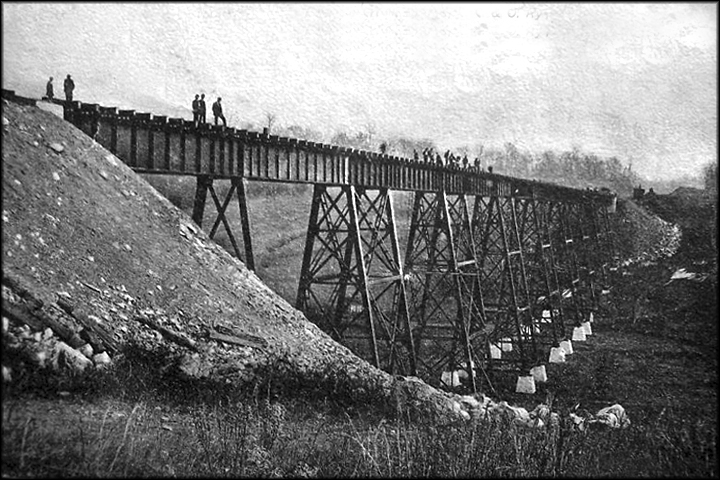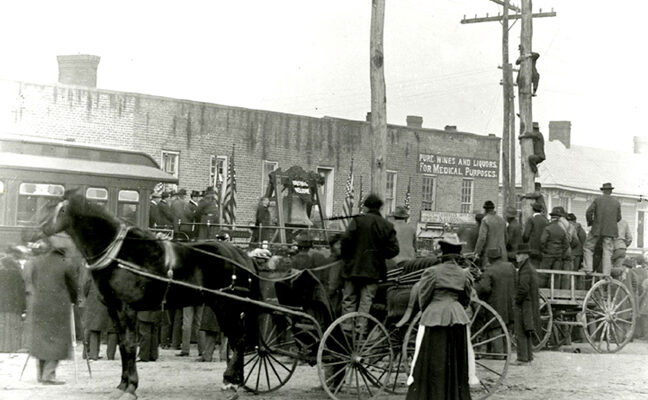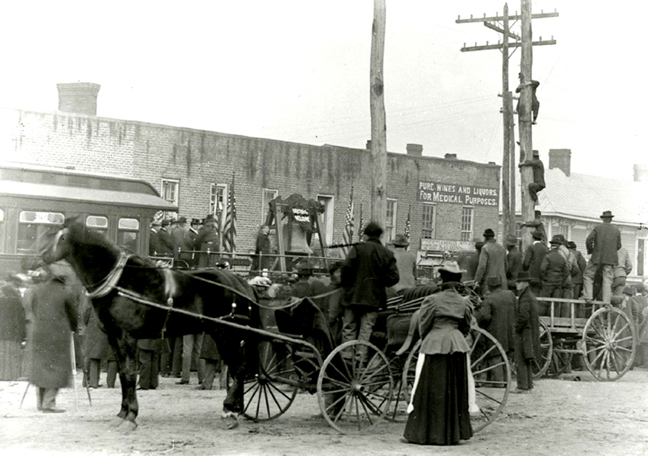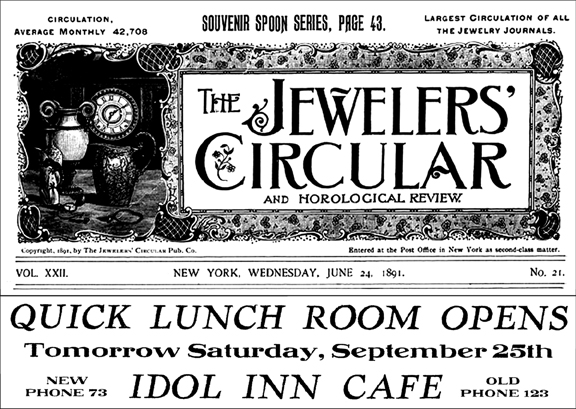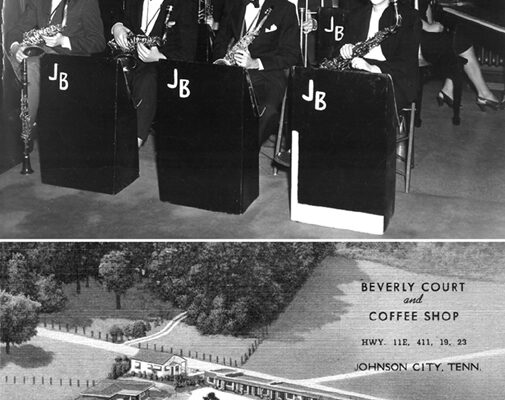Ken Riddle has glowing comments about Mary Hardin McCown in “The Cy Crumley Scrapbook, ET&WNC Railroad Historical Photo Collection,” Archives of Appalachia, ETSU). McCown, whose father, George W. Harden, was superintendent of the famed railroad, was the “grande dame of Johnson City and an expert of the narrow gauge railroad’s history.”
“Mary was a real dear old girl,” said Ken, “and was honestly the standard bearer of a lot of the history of the area for many years, when history was not so cool. She adored her dad, had a quick smile and possessed a charming persona, especially when she was talking about Cranberry, the railroad, or her daddy.”
 and Rev. Crouch (Courtesy Cy Crumley Collection).jpg)
(1908 photo of George Hardin (left, father of Mary Hardin McCown and superintendent of the ET&WNC Railroad) and Rev. J.E. Crouch (Johnson City Christian Church minister) standing in front of Tweetsie Engine 8. (Photo courtesy of the Cy Crumley Collection, Archives of Appalachia.)
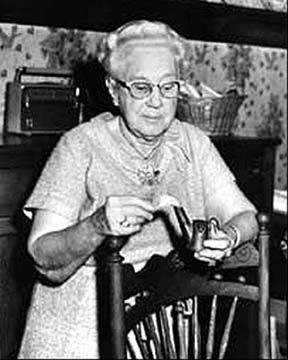
(Mary Hardin McCown from 1980.She is standing in her apartment at the Appalachian Christian Village holding what she identified as a miner's torch from the Cranberry mines. (Photo Courtesy of the Cy Crumley Scrapbook Collection, Archives of Appalachia).
The noted historian once issued a 3-page condensed documentation of her tremendous knowledge of the area’s history, titling it “Johnson City’s ‘Firsts.’” It offers a succinct description of important happenings in the city. I captured some excerpts from her work:
1772-1792: What is now Johnson City was located originally on grants of 50 shillings for 100 acres from the State of North Carolina, “along the waters of Brush Creek.” The earliest settlers were Robert Young (to the west), David Jobe (midtown who purchased the Joseph Young land) and Jacob Hoss (to the east who acquired the Joseph Young land).
Sep. 2, 1811: Most likely, the first name on record was that of “Brush Creek Settlement.” James Nelson whose father, William Nelson, owned land to the west of Robert Young, gave “4 acres 8 poles” on Brush Creek to the Methodist Society for educational and church purposes. Here was built the Brush Creek Campground, which functioned for more than half a century.
Mar. 3, 1813: A group petitioned the court to build a road that would connect to one located at Dugan’s Ford on the Watauga River that ran between Elizabethton and Blountville. It was considered to be the best route to the Salt Works in Virginia for the Brush Creek settlers.
Feb. 24, 1832: The first area post office listed was at Green Meadows with Joseph L. Burtz as postmaster. It was located about two miles west of town close to the Robert Young log cabin. It was discontinued in 1853.
Jun. 7, 1849: The Blue Plum post office opened to the east about two miles toward Carter County. Johnson was selected as the first postmaster until John H. Bowman eventually replaced him. The office closed in 1859.
1857-58: With the advent of the East Tennessee and Virginia Railroad through town, Henry Johnson moved westward after buying half an acre from Abraham Jobe.
Jul. 10, 1857: Johnson’s Depot appeared with Henry Johnson as postmaster. Tipton Jobe, both nephew and son-in-law of Abraham Jobe, sold land to the railroad for a depot, which included other necessary sites for one dollar.
Oct. 8, 1859: The name of the post office was changed to Haynesville in honor of Landon Carter Haynes, the Confederate senator who lived just south of town.
Apr. 8, 1861: The name, Haynesville, was changed back to Johnson’s Depot.
About 1864: A school was held in a house on Rome Hill (later known as Roan Hill), but was later moved to a site near the Brush Creek Campground and the big spring there.
Mar. 9, 1865: Johnson’s Depot was permanently renamed Johnson City.
1866: The Science Hill Literary Society was organized, composed of a group of young men who met for debates.
Feb. 14, 1867: After a decision was made to build a school, the hill above Nobb Spring was selected. Tipton Jobe donated two acres and 56 perches of land. At this spot, the Science Hill Male and Female Institute was built from brick that was burned on the site and laid by local labor.
Oct. 27, 1867: The Institute was dedicated with Embree Hoss and Bishop Hoss as speakers. It opened on Aug. 24, 1868 with Reverend John B. Pence serving as principal.
Dec. 1, 1869: Johnson City was first incorporated with Daniel W. Crumley as mayor. The city limits were within a radius of a half-mile from the downtown depot.
1871: A group headed by Colonel Robert Love, Elijah Simerly, W.M. Taylor and others built the first hotel in the city. It was a 3-story frame building with 40 rooms standing on the side of the railroad between the Public Square and Wilson Avenue. The contractor was Henry Hoss Crouch.
Mar. 7, 1879: The State Legislature revoked Johnson City’s charter, but reincorporated it on March 25 with Colonel S.H. Yokum chosen as mayor.
Jun. 15, 1881: The Tennessee Legislature first chartered the ET&WNC as a broad gauge road, but difficulties were encountered causing the broad gauge idea to be abandoned. Instead, the railroad was built as a narrow gauge road, with the first train going through to Cranberry, NC on that date. After a long and colorful run, the line was discontinued for through service in June 1960.
1886: The downtown high school was leased to Johnson City for five years. About 1902, the school was again leased to the city, but this time for 99 years for use as Science Hill High School. It remained a high school until 1961 when it became South Junior High.
Sep. 5, 1911: East Tennessee State Normal School was built on land donated by George L. Carver, president of the Carolina and Clinchfield Railroad. It opened in 1911 with Dr. Philander P. Claxton as speaker. The school later became East Tennessee State College and finally East Tennessee State University.
1901: Congressman Walter P. Brownlow was instrumental in establishing the Mountain Branch of the National Home for Disabled Volunteer Soldiers. About 475 acres aimed at providing domiciliary and hospital facilities were purchased from the Lyle and other families.
1903: The first hospital facility in Johnson City was a small private one established by Dr. William J. Matthews. It was housed in the Carlistle Hotel (a brick building that became known as the Franklin Apartments at the corner of E. Main and Division streets).
Mrs. McCown’s time capsule summary certainly offers a convenient resource of important dates in Johnson City’s colorful history.
 and Rev. Crouch (Courtesy Cy Crumley Collection).jpg)


